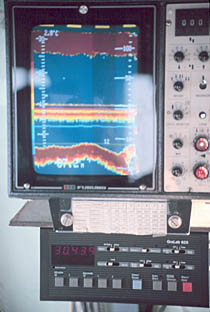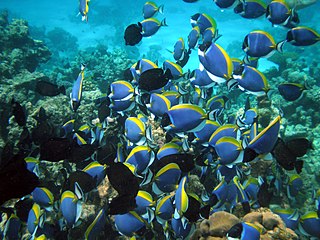
Sonar is a technique that uses sound propagation to navigate, communicate with or detect objects on or under the surface of the water, such as other vessels. Two types of technology share the name "sonar": passive sonar is essentially listening for the sound made by vessels; active sonar is emitting pulses of sounds and listening for echoes. Sonar may be used as a means of acoustic location and of measurement of the echo characteristics of "targets" in the water. Acoustic location in air was used before the introduction of radar. Sonar may also be used in air for robot navigation, and SODAR is used for atmospheric investigations. The term sonar is also used for the equipment used to generate and receive the sound. The acoustic frequencies used in sonar systems vary from very low (infrasonic) to extremely high (ultrasonic). The study of underwater sound is known as underwater acoustics or hydroacoustics.

Echolocation, also called bio sonar, is the biological sonar used by several kinds of animals. Echolocating animals emit calls out to the environment and listen to the echoes of those calls that return from various objects near them. They use these echoes to locate and identify the objects. Echolocation is used for navigation and for foraging in various environments.

Echo sounding is a type of sonar used to determine the depth of water by transmitting sound waves into water. The time interval between emission and return of a pulse is recorded, which is used to determine the depth of water along with the speed of sound in water at the time. This information is then typically used for navigation purposes or in order to obtain depths for charting purposes. Echo sounding can also refer to hydroacoustic "echo sounders" defined as active sound in water (sonar) used to study fish. Hydroacoustic assessments have traditionally employed mobile surveys from boats to evaluate fish biomass and spatial distributions. Conversely, fixed-location techniques use stationary transducers to monitor passing fish.

Bioacoustics is a cross-disciplinary science that combines biology and acoustics. Usually it refers to the investigation of sound production, dispersion and reception in animals. This involves neurophysiological and anatomical basis of sound production and detection, and relation of acoustic signals to the medium they disperse through. The findings provide clues about the evolution of acoustic mechanisms, and from that, the evolution of animals that employ them.

A bat detector is a device used to detect the presence of bats by converting their echolocation ultrasound signals, as they are emitted by the bats, to audible frequencies, usually about 120 Hz to 15 kHz. There are other types of detectors which record bat calls so that they can be analysed afterward, but these are more commonly referred to by their particular function.

Hydroacoustics is the study and application of sound in water. Hydroacoustics, using sonar technology, is most commonly used for monitoring of underwater physical and biological characteristics.
A scientific echosounder is a device which uses sonar technology for the measurement of underwater physical and biological components—this device is also known as scientific sonar. Applications include bathymetry, substrate classification, studies of aquatic vegetation, fish, and plankton, and differentation of water masses.

The NOAA Ship Delaware II is a National Oceanic and Atmospheric Administration (NOAA) fisheries research vessel that was in commission from 1970 to 2012. Prior to her NOAA career, she was in commission in the United States Fish and Wildlife Service's Bureau of Commercial Fisheries from 1968 to 1970 as BCF Delaware II.

The Pacific herring, Clupea pallasii, is a species of the herring family associated with the Pacific Ocean environment of North America and northeast Asia. It is a silvery fish with unspined fins and a deeply forked caudal fin. The distribution is widely along the California coast from Baja California north to Alaska and the Bering Sea; in Asia the distribution is south to Japan. Clupea pallasii is considered a keystone species because of its very high productivity and interactions with a large number of predators and prey. Pacific herring spawn in variable seasons, but often in the early part of the year in intertidal and sub-tidal environments, commonly on eelgrass, seaweed or other submerged vegetation; however, they do not die after spawning, but can breed in successive years. According to government sources, the Pacific herring fishery collapsed in the year 1993, and is slowly recovering to commercial viability in several North American stock areas. The species is named for Peter Simon Pallas, a noted German naturalist and explorer.

The fishing industry in Scotland comprises a significant proportion of the United Kingdom fishing industry. A recent inquiry by the Royal Society of Edinburgh found fishing to be of much greater social, economic and cultural importance to Scotland than it is relative to the rest of the UK. Scotland has just 8.4% of the UK population but lands at its ports over 60% of the total catch in the UK.

Acoustical oceanography is the use of underwater sound to study the sea, its boundaries and its contents.
Bat detectors are the most common way to identify the species of flying bats. There are distinct types of call which can indicate the genus, and variations in pattern and frequency which indicate the species. For readers not familiar with the different types of bat detector, there is further information below and elsewhere.
This is a glossary of terms used in fisheries, fisheries management and fisheries science.

Fisheries acoustics includes a range of research and practical application topics using acoustical devices as sensors in aquatic environments. Acoustical techniques can be applied to sensing aquatic animals, zooplankton, and physical and biological habitat characteristics.

Forage fish, also called prey fish or bait fish, are small pelagic fish which are preyed on by larger predators for food. Predators include other larger fish, seabirds and marine mammals. Typical ocean forage fish feed near the base of the food chain on plankton, often by filter feeding. They include particularly fishes of the family Clupeidae, but also other small fish, including halfbeaks, silversides, smelt such as capelin, and the goldband fusiliers pictured on the right.
Stock assessments provide fisheries managers with the information that is used in the regulation of a fish stock. Biological and fisheries data are collected in a stock assessment.

In biology, any group of fish that stay together for social reasons are shoaling, and if the group is swimming in the same direction in a coordinated manner, they are schooling. In common usage, the terms are sometimes used rather loosely. About one quarter of fish species shoal all their lives, and about one half shoal for part of their lives.

Ichthyoplankton are the eggs and larvae of fish. They are mostly found in the sunlit zone of the water column, less than 200 metres deep, which is sometimes called the epipelagic or photic zone. Ichthyoplankton are planktonic, meaning they cannot swim effectively under their own power, but must drift with the ocean currents. Fish eggs cannot swim at all, and are unambiguously planktonic. Early stage larvae swim poorly, but later stage larvae swim better and cease to be planktonic as they grow into juveniles. Fish larvae are part of the zooplankton that eat smaller plankton, while fish eggs carry their own food supply. Both eggs and larvae are themselves eaten by larger animals.

NOAAS Chapman was an American fisheries research vessel that was in commission in the National Oceanic and Atmospheric Administration (NOAA) fleet from 1980 to 1998. After the conclusion of her NOAA career, she spent several years operating as the University of Puerto Rico marine research vessel R/V Chapman. More recently, she has become the Curaçao-based mothership for the deep-diving submarine Curasub.

RV Corella (LT767) was a fisheries research vessel that was operated by the Ministry of Agriculture, Fisheries and Food - Directorate of Fisheries, now known as the Centre for Environment, Fisheries and Aquaculture Science (Cefas) between 1967 and 1983.



















